Pomeranian Potty Training: Schedules, Tips & Fixes
Lateef Bhatti
Author
Successful Pomeranian potty training requires the proper methods, consistency, and patience, all of which will be covered in this guide. This will include potty training schedules, crate training, the use of puppy pads, managing potty training accidents, and excitement urination. This also applies if you’re training a new Pomeranian puppy or helping an adult dog adjust. These will foster a cleaner and happier home, with lasting positive results which we will detail in this guide.
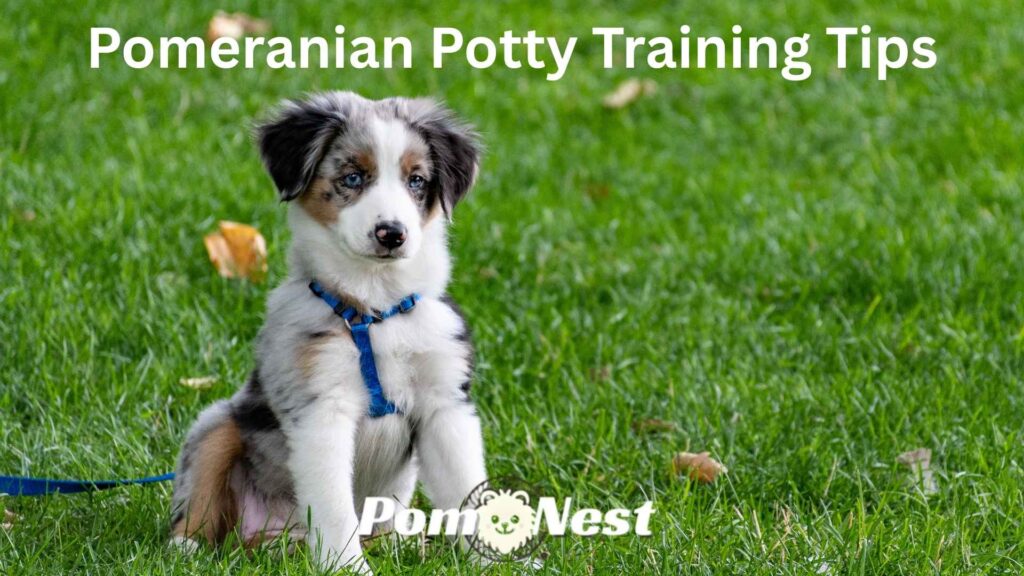
Being able to potty train a Pomeranian is a great personal achievement for new dog owners. A potty trained Pomeranian is also great to relax and spend quality time with. Accidents can happen, but with patience and ample time, your Pomeranian will pick up on your cues.
Table of Contents
ToggleTraining your Pomeranian to use the bathroom properly is a way to communicate with your dog. Having a dog use the bathroom outside is also a way to clean the house and maintain hygiene in your house. It is important for a dog to know what is expected of them so that they can gain trust and confidence, and prevent anxiety.
You can house train a Pomeranian by the use of indoor potty pads or by teaching them to go to a designated potty spot outside. Many new dog owners use a combination of crate training and playpen to prevent potty mistakes. No matter which option you choose, your best options will be patience, praise, and persistence in order to achieve long term training results.
A Little Dog with a Lot of Personality: Understanding Your Pomeranian's Personality
Pomeranians may be small but they do not lack in personality. Their playful nature productive curiosity coupled with a tad of stubbornness, makes training equally enjoyable and challenging. Understanding each individual personality will help in shaping a potty training plan.
They are attention seeking and respond quickly and enthusiastically towards praise and treat rewards. Since they are active and interactive, training helps in building a positive relationship. Pomeranians are likely to cooperate and follow instruction with an encouraged attitude.
On the other hand, their energetic personality and independent nature may lead them to test boundaries. A Pomeranian puppy challenging your commands is a normal occurrence. Keeping calm and consistency is essential, and, a lively temperament makes them delightful company.
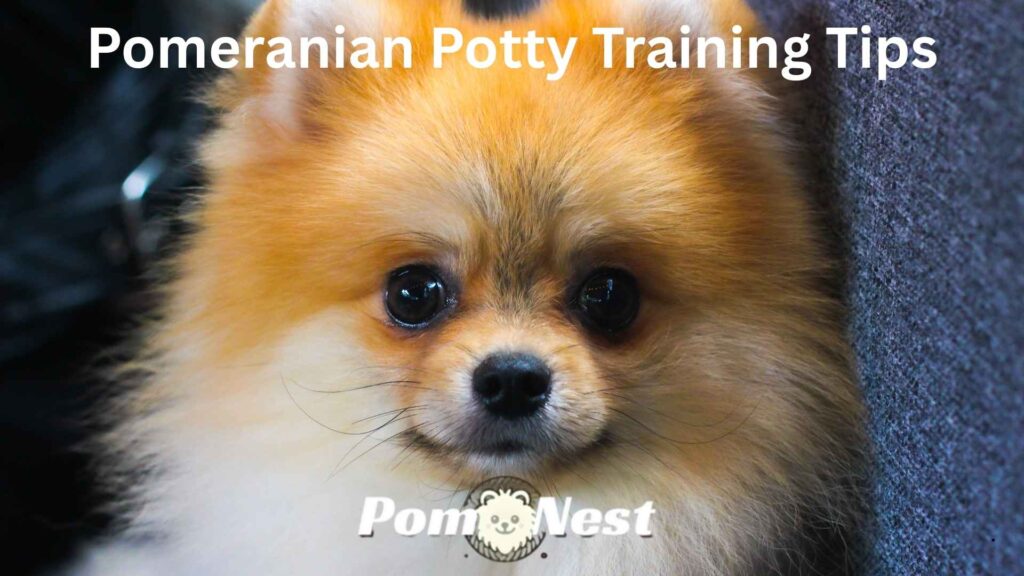
Before You Start Pomeranian Potty Training
It is essential to ensure realistic expectations when starting Pomeranians potty training. These little dogs have small bladders and will need to relieve themselves often. Having this in mind helps in keeping your patience when accidents happen.Being ready also involves having the appropriate equipment. Will you use puppy pads, a litter box, or a potty area outside? Being ready with the cleaning supplies is just as important, as being able to clean up the accident quickly helps avoid the lingering smells that will cause the puppy to continue having accidents.
Lastly, consider your schedule. How long will you be able to supervise? Your Pomeranian puppy will respond best to consistent training. If you will be gone for long periods, consider a playpen or crate training to provide a safe area so they do not wander and so you can avoid accidents in your house.
Pomeranian Potty Training Schedule
Time | Activity | Potty Break |
Early Morning | Wake up | Take outside immediately |
After Breakfast | Feeding + short play | Potty break within 10 min |
Mid-Morning | Nap / supervised play | Potty break after waking |
Afternoon | Meal or snack + play | Potty break after eating |
Evening | Playtime / family time | Potty break before dinner |
After Dinner | Feeding + calm play | Potty break within 10 min |
Late Evening | Relax time / short walk | Potty break before bedtime |
Overnight | Sleeping in crate or playpen | Optional midnight potty for young pups |
Pomeranians Potty Training: What To Expect
When training a Pomeranian, you should be prepared to encounter a few challenges. Accidents will happen while puppies learn what you expect from them. Your frustration, however, will be more effective if you remain calm and consistent.
Pomeranian puppies need to take frequent potty breaks. Each puppy is different, and some may take a longer time learning the process, as it depends on the puppy’s age, health, and character. Repetition is the answer, and every time you take a puppy to the potty area, you help the puppy make the connection.
Some progress is more normal than others. A puppy may succeed for a week and then regress. This is normal for a puppy because it is learning just like a child.
Tips to Potty Train a Pomeranian
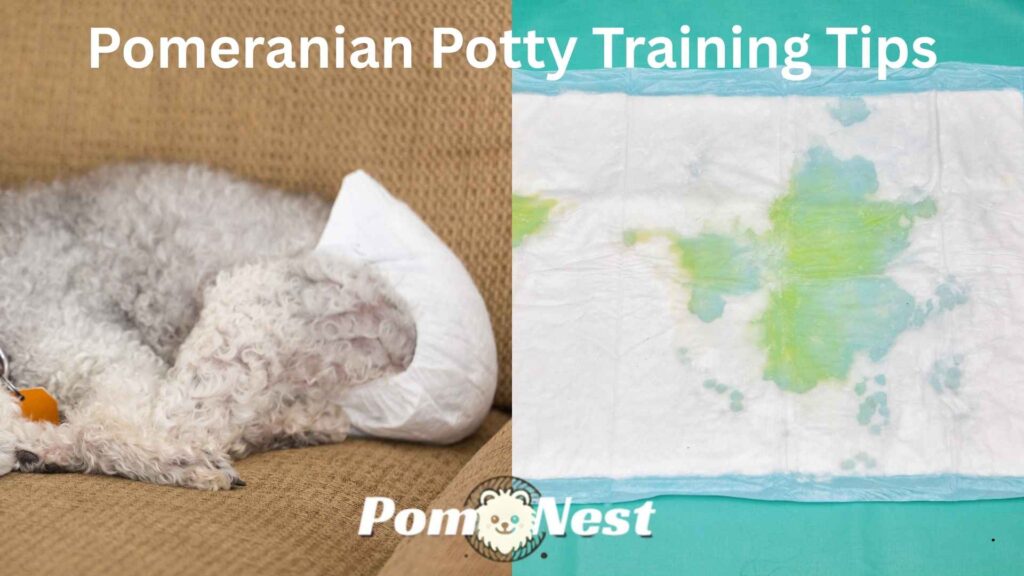
Easier Pomeranian training arises from breaking down training into smaller steps to reduce overwhelm. Concentrate on making progress instead of making the experience perfect. Each win, such as a successful trip to the potty spot, should be celebrated!
The golden rule is consistency. Take your Pomeranian puppy to the potty spot at the same times every day. They will learn the routine, and over time this will become a strong habit which also lessens the chances of potty accidents.
If you’d like to simplify the potty training journey, here is a list of practical, vet-approved tips. Use them consistently, and you will see steady progress in your puppy’s behavior.
Pomeranian Potty Training Helpful Hints
- Choose a designated potty area and stick with it.
- Use command “go potty.”
- Learn the early signs (sniffing, circling, whining).
- Take frequent trips outside or to the puppy pads.
- Accidents should be cleaned immediately to prevent repeated spot.
- Feeding times should be controlled to provide predictable bathroom breaks.
- During free play, supervise closely.
- Stay consistent — changing methods too often is unhelpful.
- Post success, ALWAYS praise and reward.
- Active progress is the best part!
Establishing a Training Space
Establishing the appropriate training environment for Pomeranian potty training allows for a more seamless experience. A puppy’s best learning occurs in a calm environment that is orderly and free of disruptive elements. If a dog feels secure, the anxiety will recede and the need for restless behaviors will diminish during their learning sessions.
When you cannot supervise your Pomeranian puppy, a playpen or crate system will help you manage the space they have. This will encourage them to learn the rules of potty training and bladder control by limiting the frequency of potty breaks. Self-control is easier to learn when a puppy is in a smaller space.
Make sure the designated potty area is easy to access and consistent. Whether it’s a spot in your yard, a litter box indoors, or puppy pads in one corner, keep it the same every time. Familiarity helps your dog recognize where to go and builds confidence in their training routine.
Positive Reinforcement Techniques
Positive reinforcement is the heart of Pomeranian potty training. Instead of punishing mistakes, focus on rewarding the right behavior. Your puppy will quickly learn that using the designated potty area leads to something good.
Right after your Pomeranian puppy finishes going in the correct spot, offer praise and treat rewards. Use an upbeat tone and be consistent with your response. This immediate feedback helps your dog associate the action with the reward.
As your puppy matures, you can gradually reduce the number of treats while keeping verbal praise strong. This keeps the habit going without over-relying on food. In time, your dog will use the bathroom in the right place simply because it’s what they know to do.
Litter Box & Pee Pad Training
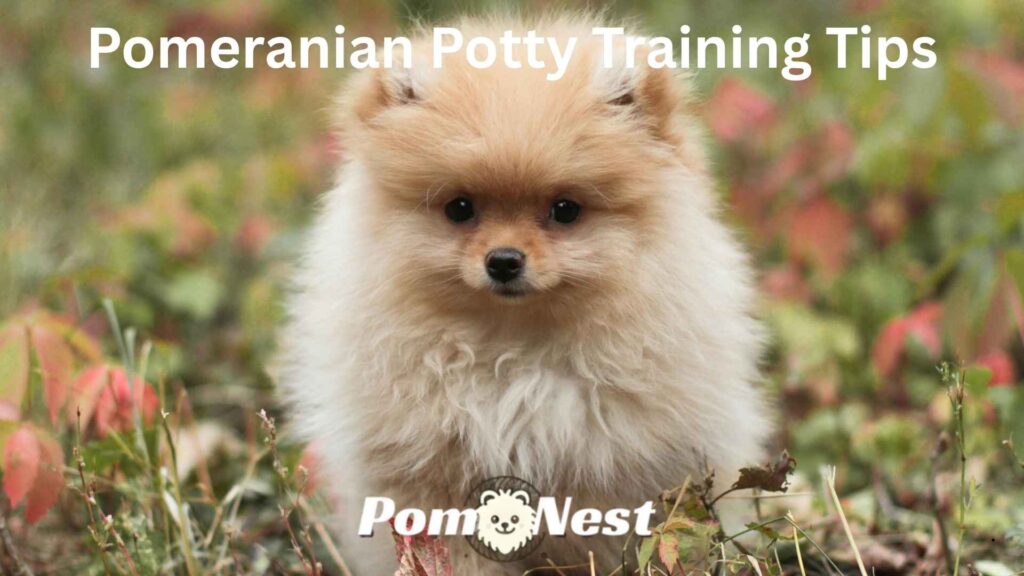
Many owners find pee pads very helpful when it comes to house-training a small dog. Puppy pads provide a reliable indoor option if you live in an apartment or cannot regularly take your Pomeranian outside. Once you place the pad in a specific location, your dog will eventually understand where to go. After some time, your Pomeranian will associate the area with bathroom breaks.
Some owners may be asking themselves, “Can you litter box train a Pomeranian puppy?” The answer, yes. Small breeds such as Pomeranians can easily adjust to dog-specific litter boxes made to their size. It functions much like a cat’s setup but with dog-safe litter added. This method is especially useful in providing relief when the weather is cold, when your dog is older, or for those times when it is impractical to go outside.
In order for both pee pad and litter box training to be successful, you must have a system in place. Each time after a meal, nap, or play session, guide your puppy to the pad or box. When they successfully use it, provide treats as a reward. When an accident happens, clean up the mess and do not leave any lingering scents that could confuse your Pomeranian. With time and patience, your Pomeranian will succeed in reliably using the designated potty area.
Litter Box & Pee Pad Training Supplies for your Pomeranian
- AmazonBasics Dog and Puppy Pee Pads (Regular or Small Size). Good quality, absorbent to pee and perfectly suitable for small breeds like Pomeranian.
- Four Paws Wee-Wee Pads for Small Dogs. Intended for small pups with patented quick-dry technology.
- Glad Activated Carbon Training Pads. Great for neutralizing odors and leak protection during indoor training.
- Fresh Patch Real Grass Dog Potty. Helps to ease dogs to outdoor potty training.
- DoggyLawn Disposable Grass Pad. Environment-friendly, real grass option ideal for apartments.
- IRIS Dog & Puppy Training Pad Holder. Keeps pads in place so your Pom won’t be able to shred or drag them off.
- PAW TRAX Mesh Training Tray. A reusable tray that holds pads securely and leak proof.
- PetSafe Pet Loo Portable Indoor Dog Potty. A reusable synthetic grass toilet system for long-term use.
- Simple Solution Puppy Aid Training Spray. To encourage puppies to consistently use pads by marking the Pad with an attractant.
- Rocco & Roxie Stain & Odor Eliminator. Enzymatic Cleaner for cleaning marked “accident” areas and helping to avoid repeat marking.
Crate & Adult Training
Crate training a Pomeranian puppy is one of the best methods for house breaking. Puppies tend to avoid soiling their sleeping area. Gradually introduce the crate. It should contain some toys, a blanket, and other comforts so the puppy does not think of the crate as a punishment. Eventually, the puppy will view the crate as a cozy personal den.
In addition to providing security, crate training and socialization, and establishing a routine for the puppy are all possible. It teaches the puppy confidence and control of their bladder when coupled with regular potty breaks. The most important part is timing: right after a potty break, take the Pomeranian outside, or to their designated potty area.
If you are trying to potty train an adult Pomeranian, the good news is, it´s possible. Adult dogs may take longer to house train, especially if they have some bad habits. You will have to develop some routine. Adult dogs may take longer to potty train, especially if they have some bad habits. You will have to develop some routine. Supervision will have to be close and it will be necessary to reward, and when they have an accident, you have to be thorough in your clean up. Adults may require more coaxing, but it is possible to teach a dog of any age.
Resolving Pomeranian Potty Training Problems
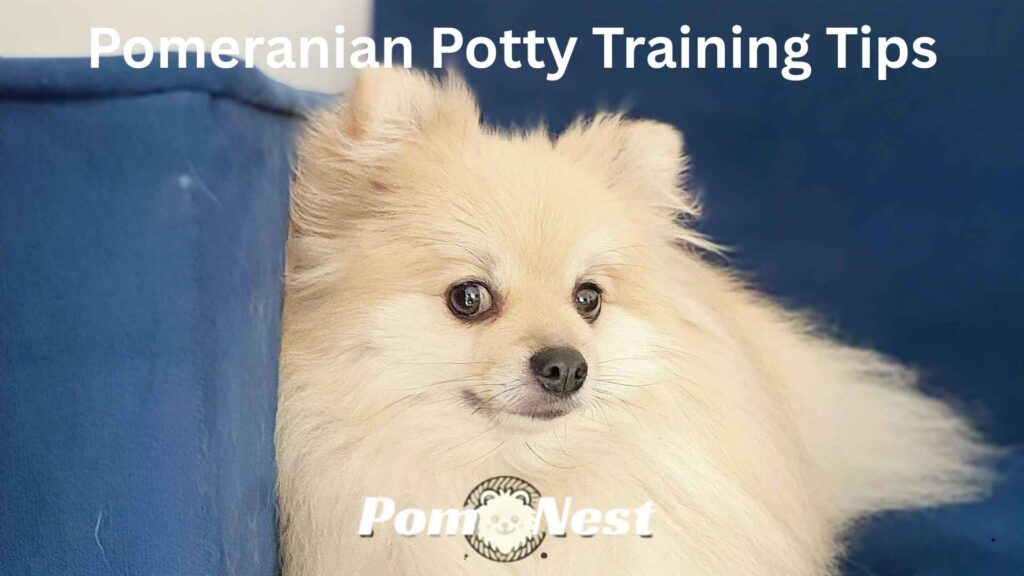
Problems might arise even with Pomeranian potty training plans that are well-structured. Throughout the process, owners might encounter stubbornness. In these situations, owners must avoid exasperation. Are the accidents occurring after meals, during play, or when the owner is inattentive?
Calm handling of the situation when the potty training accidents occur is necessary. Punishing a Pomeranian is ineffective, as it only communicates and reinforces fear. Accidents should be cleaned with a special enzymatic cleaner that eliminates additional odors. Dogs repeating a behavior, in this case, urination, are driven by scent.
Some Pomeranians and other breeds might experience submissive or excited urination when greeting other people. This is a training issue, as the control is more emotional than it is behavioral. Excited greetings will only serve to exasperate the issue. Over time, the issue will self-correct. This issue will self-correct with time, confidence building, and low reinforcement.
Progress and Long-Term Success
Potty training a Pomeranian does not happen overnight. In general, the process takes a couple of weeks to several months. Much depends on the dog’s age, training consistency, and individual differences. Puppies tend to take longer, and adult dogs may already have established the habits that most trainers try to change.
You can measure progress by recording the number of successful potty breaks and the number of accidents. As a Pomeranian develops bladder control, the number of mistakes will decrease. More reliable behavior will emerge, too. Don’t forget that setbacks are a part of the process. They are not an indicator that training is ineffective. With consistent effort, training stubborn dogs is a matter of time.
You can celebrate once your dog is using the potty area reliably. Continue praise and treat rewards, even less frequently, to reinforce the behavior. The relaxation that you feel is a result of your patience and consistent scheduling to reinforce the acquired habits. With time, potty training will feel natural to both you and your Pomeranian.
Concluding Remarks
Although training your Pomeranian to use the bathroom requires a lot of time, patience, and consistency, the benefits of a more pleasant home certainly justify the efforts. By creating the right environment, employing positive reinforcement, and maintaining a consistent schedule, your Pomeranian’s odds of success are greatly increased.
Every dog is an individual and will learn at their own speed. There are those puppies that will learn quickly, but other will require more of your time and instruction. Do not become frustrated by what seems to be a lack of progress: even losing is part of the training. Calmly and consistently rewarding your Pomeranian will bring success in the end.
The training of your dog is important, but the relationship that you build is just as crucial as the end result. An unwavering resolve will bring a positive result in both the training and in the relational bond that you have with your Pomeranian. That is your training success story, and a success story for both you and your dog.
FAQs
Not really. Pomeranians are quick learners. However, having a small bladder and a stubborn-attention-seeking personality requires more frequent attention to a broken and consistent routine.
First, set and rule health issues with a vet, then accidents can be preferably avoided with supervision or crating, following a strict potty schedule then closing the reward trap, and removing odor with an enzymatic cleaner to ensure they won’t return to the same place.
It’s an intensive, short-term method (often marketed for kids or pets) that involves near-constant supervision, repeated potty trips, immediate praise for success, and confinement when unsupervised — it can jump-start the learning, but is intense and not realistic for every household.
The 10-10-10 approach structures potty breaks and supervision: generally take your pup to the potty for a focused 10 minutes, then a 10 minute interval of close supervision or short play, then a period of rest/crate to round out resting for 10 minutes that adds a rhythm to the day and provides a simple expectation to relieve your pup from the crate.
The recommended strategy includes the following components: preventing accidents (using close supervision and a crate), maintaining a feeding and potty schedule, providing immediate rewarding for the appropriate behavior, and practicing patient repetition. So, crate training along with frequent, timed potty trips is considered the quickest and most reliable method.
